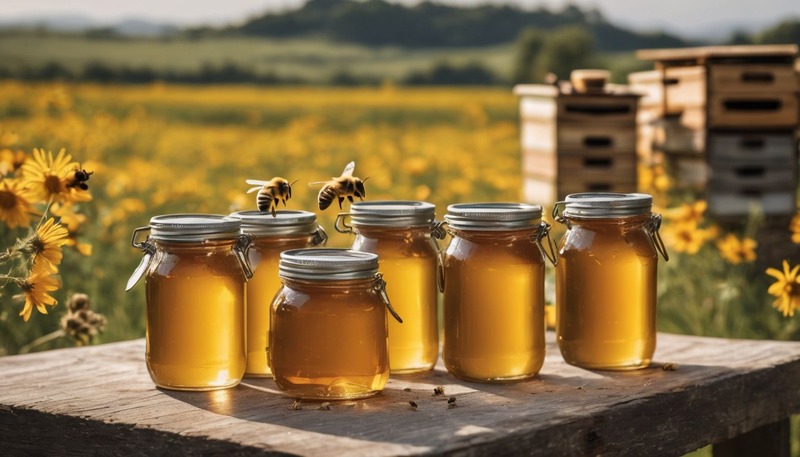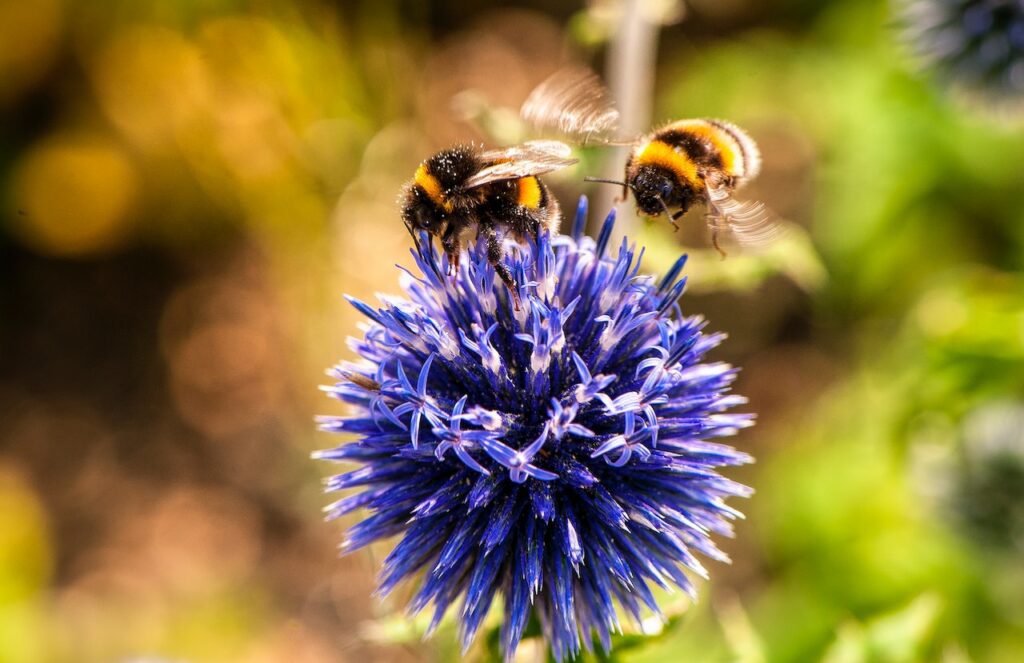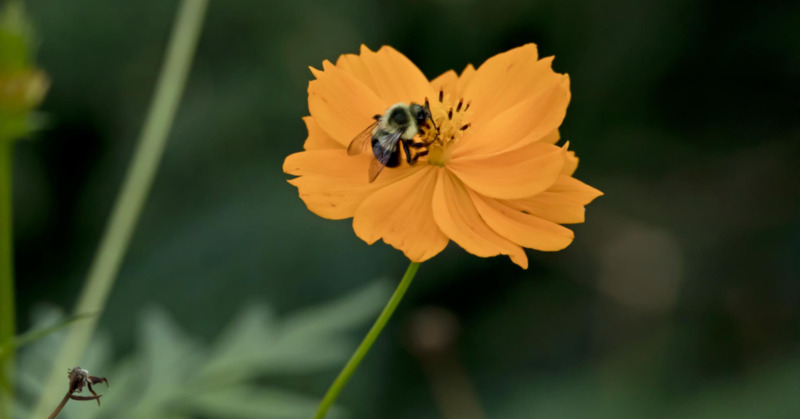Are you curious about turning your interest in beekeeping into a source of income?
If you didn’t know, bees offer diverse income streams, from selling honey at $10 per pound to providing pollination services and more.
This guide will equip you with vital tips on profitable beekeeping – the ins and outs of starting up, choosing products to sell, managing hives, and scaling your venture.
Ready for an exciting buzz into money-making with bees?
Let’s dive in!

Key Takeaways
- Beekeepers can make money with bees by selling bee products such as honey, beeswax, pollen, and propolis.
- Offering pollinator services to farmers during the flowering season is another way for beekeepers to earn income from their hives.
- Beekeepers can also generate additional income by selling bee equipment and providing advisory services to other beekeepers.
- Becoming a pollinator seeds supplier is a profitable option for beekeepers, as there is a growing demand for pollinator-friendly plants.
- Regular hive inspections are necessary to maintain healthy beehives and maximize profitability in beekeeping.
- Start-up costs include purchasing beekeeping equipment like hives and protective gear, while operating costs involve factors like feeding bees and managing pests.
- Time commitment plays a significant role in successful beekeeping, requiring regular attention throughout the year for tasks like hive management and honey harvesting.
5 Ways to Make Money with Beekeeping
There are several ways to make money with beekeeping including:
- Selling bee products,
- Offering pollinator services,
- Selling bee equipment,
- Providing advisory services,
- And becoming a pollinator seeds supplier.
Below we’re going to take a closer look at each so keep reading!
1. Selling Bee Products
Let’s start with the things that bees produce – and yes, it’s more than just honey!
Here’s how you can earn a solid income from all the things produced by bees:
- Honey: Honey is popular and sells for around $10 per pound. A beekeeper can make up to $600 from one hive in one year. You can also sell honey with unique flavors if you have specific nectar sources nearby. There is always demand for natural and locally produced honey.
- Beeswax: Beeswax has many uses. People use it in candles, lip balms, and creams. A common retail price for this is $10 per pound.
- Pollen: Health nuts love pollen! It’s a superfood that boosts health and wellness. It even has a higher market value compared to honey due to the small amounts available per hive. This sells for around $3-5 per ounce.
- Propolis: Rare but valuable, propolis also offers many health benefits and this is why people are willing to pay for it. It usually sells for $6-8 for an ounce.
Some other bee products you could sell are royal jelly and bee venom, but these are difficult to harvest.
2. Offering Pollinator Services
Beekeepers can also make money by offering pollinator services.
Many farmers rely on bees for the pollination of their crops as bees play a crucial role in the reproductive process of plants.
Renting out your beehives to farmers during the flowering season is a valid way to earn additional income. The demand for pollination services is high, especially in areas where there are large-scale agricultural operations.
This can be a very profitable venture for beekeepers, as you are compensated for the use of their bees in crop pollination. Generally, the farmers can pay up to $150 for this type of service.
Providing pollinator services also helps support local agriculture and promotes biodiversity by ensuring the health and abundance of flowering plants.
3. Selling Bee Equipment
Beekeeping not only involves working with bees and selling their products, but it also presents an opportunity to make money by selling bee equipment.
As a beekeeper, you can offer essential supplies like hives, frames, protective clothing, smokers, extractors, and other tools needed for beekeeping.
Many aspiring beekeepers will need these items to start their own colonies or expand existing ones. When you provide quality equipment at competitive prices, you can tap into this market and earn additional income from your beekeeping business.
With the increasing interest in sustainable agriculture and backyard beekeeping, the demand for bee equipment is on the rise. So by offering these necessary tools of the trade, you can contribute to the success of fellow beekeepers while boosting your profits as well.
4. Providing Advisory Services
You can also make money in beekeeping by providing advisory services.
As a beekeeping expert, you can offer your knowledge and skills to others who are starting or managing their own beehives.
This could involve helping them with hive management, pest control, honey extraction, and other aspects of beekeeping. Sharing your expertise is a fulfilling way to earn an income while supporting the success of fellow beekeepers.
5. Becoming a Pollinator Seeds Supplier
Becoming a pollinator seeds supplier is another way to make money related to bees.
You can provide seeds that attract and support pollinators to tap into the growing demand for pollinator-friendly gardens and landscapes.
These seeds can be sold individually or in bulk to nurseries, garden centers, or directly to consumers. With the decline in pollinator populations, there is a need for more sources of quality pollinator-friendly plants.
You can offer a variety of native flowers and plants that attract bees and other beneficial insects to contribute to their conservation while earning an income from your beekeeping venture.
What Are Some Factors Affecting Profitability in Beekeeping?

Start-up costs
Starting a beekeeping business requires some initial investment.
You will need to purchase beekeeping equipment such as hives, frames, protective gear, and tools. The cost of these items can vary depending on the quality and quantity you choose (more about this later).
Also, you will need to buy bees or acquire them through other means, which can also have associated costs.
Hive management
Proper hive management is the key to successful beekeeping and maximizing profitability.
You need to do regular inspections to ensure the health of the colony, identify any issues or diseases, and take necessary actions.
This includes monitoring population levels, checking for signs of pests, such as varroa mites, and maintaining a clean and hygienic hive environment. Proper food supply is also vital, especially during periods of low nectar flow or winter months when bees rely on stored honey.
Providing supplemental feeding when needed helps prevent starvation and keeps the bees strong and productive. On another note, managing swarming behavior by providing sufficient space for the expanding colony can help maintain hive strength and prevent losses.
When you do a good job at hive management, you can support the bee colonies’ well-being and at the same time increase your chances of profitable beekeeping.
It’s also important to keep them in a clean environment to promote good hygiene.
Regulations and legal implications
Beekeeping is subject to regulations and legal requirements that vary from place to place.
Before starting a beekeeping business, you’d do well to research and understand the rules in your area.
Some common regulations include obtaining permits or licenses, registering your apiary with local authorities, and following specific guidelines for hive placement and maintenance.
Failure to comply with these regulations can result in fines or other penalties.
There may also be laws regarding honey labeling and sales that you need to adhere to when selling your products.
Time commitment
Beekeeping requires a significant time commitment.
You need to regularly inspect hives to ensure the health and productivity of the bees.
This can involve checking for signs of disease, monitoring honey production, and managing swarming behavior.
Also, beekeepers need to harvest honey and other products from the hive at the right time to maximize profit. Time must also be dedicated to tasks like cleaning equipment and maintaining the apiary.
While exact time requirements may vary depending on factors like your hive size and management practices, beekeeping is generally considered a hands-on endeavor that demands regular attention throughout the year.
What Are The Estimated Profits In Beekeeping?
So, how much can you earn with bees?
This comes down to determining start-up and operating costs, along with implementing effective pricing strategies that are key factors in estimating profit in beekeeping.
Let’s take a closer look.

Pricing strategies
Pricing your products/services plays a big role in maximizing your profits.
One approach is to do market research and determine the going rate for honey and other bee products in your area.
This will help you set competitive prices while ensuring you earn a fair profit.
Another strategy is to offer different package options or sizes to cater to various customer preferences and budgets.
You also want to consider the demand and seasonality of your products when setting prices – during peak seasons like spring and summer when honey production is highest, you may be able to charge slightly higher prices.
Determining start-up and operating costs
Next, let’s see how much everything costs.
Becoming a beekeeper and starting a profitable beekeeping business involves accurately figuring out your start-up and operating costs.
| Item | Start-up Cost | Operating Cost |
|---|---|---|
| Beehive | Typically, each beehive can cost around $200-$300. | Each hive can potentially generate a profit of $600 per year by selling honey. |
| Beekeeping Equipment | Beekeeping equipment such as suits, veils, and smokers can cost around $100-$200. | This is a one-time cost, but replacements and repairs might be needed over time. |
| Bee Colonies | A colony of bees can range from $100-$200. | Bee colonies help in producing honey and other bee products for sale. |
| Legal Fees and Licenses | Regulatory and legal requirements vary, costs can range from $50-$200. | Annual license renewals and regulatory fees might apply. |
| Honey Extraction and Processing Equipment | Costs can range from $200-$500. | Periodic maintenance and upgrade might be necessary. |
These are basic start-up and operating costs.
Other costs such as land, labor, marketing, packaging, and shipping costs should also be considered for a comprehensive analysis.
And all these costs can vary depending on where you live obviously.
Break-even point analysis
To determine the break-even point in beekeeping, you need to figure out how many products or services you need to sell in order to cover your costs.
This analysis helps you understand when you will start making a profit.
By calculating expenses like hive management, equipment, and time commitment, you can set prices for your honey and other products that ensure profitability.
You need to factor in both fixed costs (like equipment) and variable costs (like feeding the bees) when making the break-even analysis.
The goal is to reach a point where your sales revenue exceeds your total costs, so you can start earning money from your beekeeping business.
Scaling a profitable beekeeping business
Scaling a profitable beekeeping business involves expanding your operations to increase your income and reach more customers.
One way to scale up is by increasing the number of beehives you have.
When you add more hives, you can produce and sell more honey, beeswax, pollen, propolis, and other bee products. Another approach is to offer pollinator services on a larger scale. This means renting out your bees for agricultural pollination or partnering with farmers in need of pollinators.
You can also expand your business by selling bee equipment like hives and protective gear or providing advisory services to new beekeepers.
Now, scaling up requires careful hive management, understanding regulations and legal implications, and considering factors like start-up costs and time commitment.
When you’re just starting out, it’s best to learn the ropes first before you get more hives.

Want To Start A Profitable Website Around Bees?
Every business needs an online presence these days.
With your own (bee) website, you can market and sell your bee products, or you can simply write about beekeeping and turn it into a content-based business that earns with affiliate marketing and display advertisements.
If this sounds interesting and you’d like to learn more, I have a detailed video course for you below;
Start your own money-making bee website.
It comes with step-by-step training, website hosting, SEO tools, and a community of like-minded individuals to help you build, manage, and scale your website.
Check it out before you go!